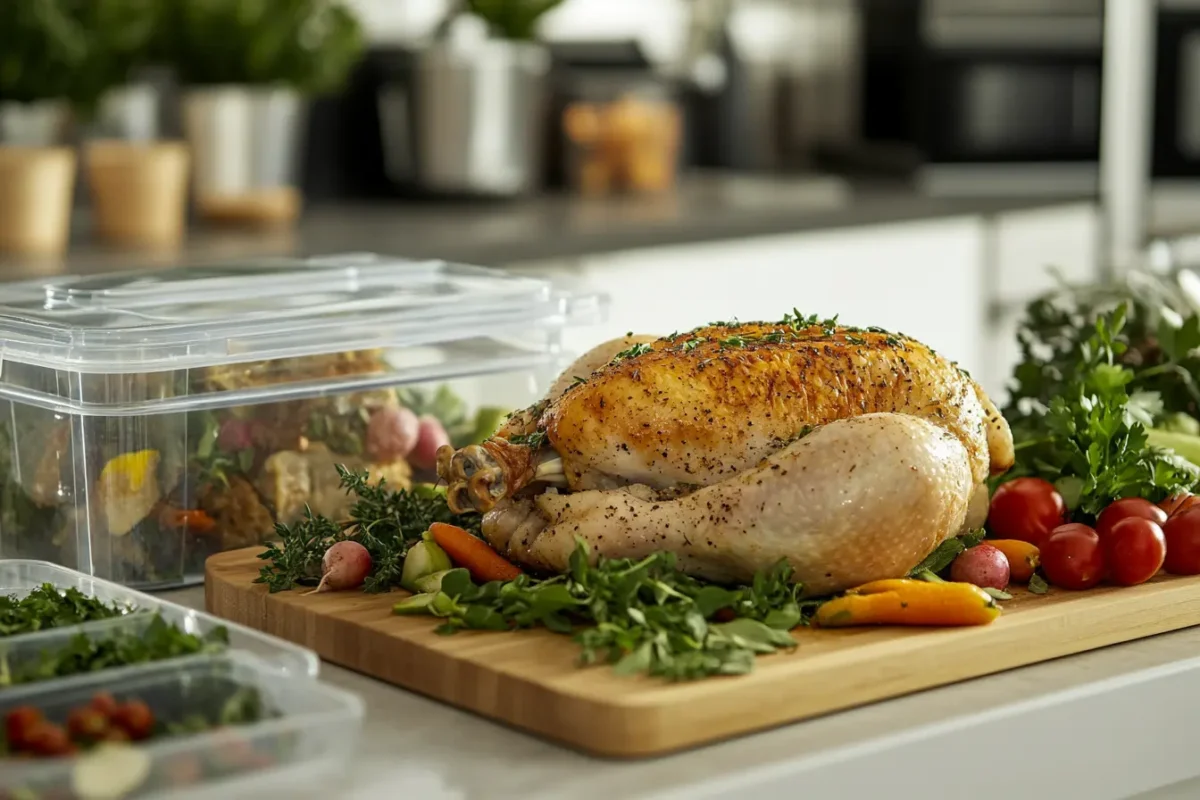If you’ve ever wondered how to freeze rotisserie chicken for later use, this guide will show you exactly how to preserve its flavor and freshness. Freezing rotisserie chicken is a game-changer for busy households. Whether you bought a bird and couldn’t finish it, or you’re prepping meals for a hectic week ahead, learning how to freeze rotisserie chicken properly can save you time and money.
Why Freezing Rotisserie Chicken Is a Smart Idea
Freezing rotisserie chicken isn’t just convenient—it’s a fantastic way to extend the life of your leftovers. But before you start, it’s important to understand what freezing cooked chicken involves and why it’s such a useful option.
What Does Freezing Rotisserie Chicken Involve?
Freezing rotisserie chicken means preserving it in a way that retains its flavor, texture, and nutritional value. It’s essential to follow proper storage techniques, like using airtight containers or freezer-safe bags, to protect the chicken from freezer burn.
When you freeze cooked chicken, its moisture content is locked in, which helps maintain its tenderness. However, improper freezing can cause it to dry out, so careful handling is key.
Why You Might Want to Freeze Rotisserie Chicken
Meal Prep Benefits
Imagine coming home from work and realizing dinner is practically ready. That’s the beauty of freezing rotisserie chicken. Pre-portioned and ready to go, it saves you from the hassle of cooking from scratch.
Preventing Waste
Got a half-eaten rotisserie chicken sitting in the fridge? Instead of letting it go bad, freezing it ensures you can enjoy it later without any waste. Plus, you’ll always have a quick protein option on hand for soups, salads, or sandwiches.
Freezing rotisserie chicken allows you to make the most out of your purchase while keeping your meal planning stress-free. With the basics covered, you’re ready to learn how to freeze chicken in a way that works for you.
A Guide to Freezing Chicken the Right Way

Freezing rotisserie chicken might sound simple, but doing it the right way ensures that the texture, flavor, and nutritional quality remain intact. Here’s a detailed guide to freezing chicken in different forms for maximum convenience.
Best Practices for Freezing a Whole Chicken
Freezing rotisserie chicken might seem simple at first, but doing it correctly is essential to preserve the texture, flavor, and nutritional quality. Therefore, following the proper steps can make a significant difference in the outcome. Here’s a detailed guide to freezing chicken in different forms for maximum convenience.
- Cool the Chicken First
Before freezing, always let the chicken cool completely. Otherwise, placing a warm chicken directly into the freezer could cause moisture loss and affect its texture. In addition, this prevents freezer burn and ensures better results. - Use Proper Packaging
Once cooled, wrap the chicken tightly in foil or plastic wrap. Then, place it in a freezer-safe airtight container or bag. As a result, this double-layer method protects it from freezer burn, maintaining its quality. - Label the Container
Furthermore, always include the freezing date on the label. This step ensures you can track its storage time, as frozen rotisserie chicken is best consumed within four months for optimal flavor.
By following these steps, you ensure that your frozen chicken retains its juicy flavor when reheated.
Tips for Storing Chicken in Portions
For versatility, consider dividing the chicken into portions before freezing. This approach lets you defrost only what you need for a specific meal.
- Cut and Wrap Individual Pieces
Remove wings, breasts, thighs, and drumsticks, and wrap each piece in plastic wrap to avoid them sticking together. - Organize in Freezer Bags
Place the wrapped pieces into a single freezer bag, removing as much air as possible before sealing it. - Mark and Store
Label the bag with the date and portion size for easy identification.
This method is perfect for soups, salads, or dishes where you need specific chicken cuts without thawing the entire bird.
Storing Shredded Chicken for Easy Use
Shredded chicken freezes beautifully and is a meal prep hero. It’s easy to portion and works wonders in tacos, grain bowls, or casseroles.
- Shred While Warm
Shred the chicken with a fork, your hands, or a stand mixer while it’s still warm. It’s easier to handle and produces finer pieces. - Divide into Portions
Split the shredded meat into individual servings to make defrosting and cooking a breeze. - Store Flat
Place each portion in a flat freezer-safe bag, press out the air, and seal it. Flattening the bags saves space and speeds up thawing.
Tip: Don’t throw away the bones! Use them to make a flavorful chicken stock for future recipes.
Safely Thawing Frozen Chicken
Defrosting frozen chicken the right way is just as important as freezing it properly. Therefore, taking the time to thaw it correctly ensures both safety and flavor. In fact, preserving the taste and texture often depends on using the right technique. Here’s how to thaw chicken based on its form.
Safely Thawing a Whole Chicken
- In the Refrigerator
The safest method is to transfer the chicken from the freezer to the fridge. Let it thaw overnight or for about 24 hours, depending on the size. As a result, the chicken will thaw evenly and retain its natural juices. - In Cold Water
However, if you’re short on time, you can use the cold water method instead. To do this, place the wrapped chicken in a bowl of cold water. Moreover, ensure you change the water every 30 minutes to maintain a safe temperature until the chicken is fully thawed.
Tips for Thawing Chicken Pieces or Shredded Meat
- Refrigerator Thawing
Similar to thawing a whole bird, place the chicken in the fridge overnight. Pieces thaw faster—typically in 4–6 hours. - Quick Water Method
For faster results, submerge individual portions in a sealed bag in cold water. Most pieces thaw within 2–3 hours.
Important: Once thawed, use the chicken immediately and never refreeze it. This ensures the chicken stays flavorful and safe to eat.
Now that you know how to freeze and thaw chicken effectively, you’re ready to save time and reduce waste.
Part 4: How Long Can You Freeze and Store Rotisserie Chicken?
According to the USDA, frozen cooked chicken is safe indefinitely if stored at 0°F or below, though quality is best within four months. Learn more from the USDA Food Safety Guidelines.
Best Practices for Freezing Rotisserie Chicken
According to the USDA, cooked chicken, including rotisserie chicken, can be safely stored in the freezer for up to four months without a noticeable drop in quality. While it’s safe to eat after this period if stored continuously at 0°F, you may notice changes in texture or taste.
Key Tips for Longevity
- Use Airtight Containers: These prevent moisture loss and freezer burn, both of which can affect the chicken’s quality.
- Label and Date: Always write the freezing date on the package. This helps you track how long the chicken has been frozen.
- Avoid Frequent Thawing: If you only need a small amount, portion the chicken before freezing to avoid unnecessary thawing and refreezing.
Proper storage techniques ensure that when you ask yourself, “Can you freeze rotisserie chicken to use later?” the answer remains a resounding yes!
Signs That Frozen Rotisserie Chicken Is No Longer Good
Even with the best storage methods, frozen chicken won’t last forever. Look out for these warning signs:
- Freezer Burn: If the chicken has white, dry patches, it may be safe to eat but could taste off.
- Odd Smell: A sour or rancid odor when thawed indicates spoilage.
- Texture Changes: If the meat becomes mushy or slimy after thawing, it’s best to discard it.
Keeping an eye on these signs ensures your meals remain safe and enjoyable.
Part 5: FAQs About Freezing Rotisserie Chicken
Freezing rotisserie chicken might seem simple, but it comes with questions. Let’s address some common ones.
Can Cooked Chicken Be Frozen Again?
Yes, you can freeze reheated rotisserie chicken, but only if it was properly stored before reheating. Cool it quickly and freeze within two hours to avoid bacterial growth. However, repeated freezing and thawing can affect texture and taste, so it’s best to freeze it once.
What Happens to Chicken Texture After Freezing?
The texture of chicken may become slightly drier after freezing, especially if it wasn’t properly sealed. However, shredding the meat or adding it to moist dishes like soups or casseroles helps maintain its tenderness.
Can You Refreeze Thawed Chicken?
Refreezing isn’t recommended unless the chicken was thawed in the refrigerator and has not been left at room temperature. Repeated freezing and thawing can impact quality and increase the risk of bacteria.
Is It Safe to Freeze Rotisserie Chicken with the Bones?
Yes, freezing chicken with the bones is safe. In fact, the bones help retain the chicken’s moisture and flavor during freezing. Just be sure to wrap the chicken tightly to protect it from freezer burn.
For more meal prep tips and ideas, check out our recipe articles on Peaceful Recipes.
Part 6: Creative Ways to Cook with Frozen Chicken

Having frozen rotisserie chicken on hand is a lifesaver, especially for busy days when cooking from scratch isn’t an option. Here are some practical tips to make the most out of your frozen chicken and ensure it stays delicious.
Quick Meal Ideas Using Thawed Chicken
Frozen rotisserie chicken is incredibly versatile, making it a valuable addition to countless meals. Moreover, it saves time and effort when you’re in a hurry. Here are a few ideas to make the most of it:
- Soups and Stews: Shredded chicken is perfect for soups like chicken noodle or tortilla soup. As a result, you can enjoy a quick, hearty meal that requires minimal preparation.
- Salads: In addition, thawed pieces can be tossed into a Caesar salad or a protein-packed grain bowl. This creates a healthy, satisfying lunch with little effort.
- Tacos and Wraps: For a flavorful twist, use seasoned chicken in tacos, burritos, or lettuce wraps. Furthermore, adding spices after thawing enhances the taste.
- Casseroles and Pasta Dishes: Chicken pairs beautifully with creamy sauces, pasta, or rice. Therefore, it’s an excellent choice for comfort food that’s both simple and delicious.
Rotisserie chicken pairs beautifully with pantry staples. For a great side dish, explore Good Side Dish for Kielbasa and Cabbage.
Reheating Frozen Chicken While Keeping It Juicy
When reheating thawed rotisserie chicken, maintaining its juiciness and flavor is key. Follow these tips for the best results:
- Low and Slow: Reheat in the oven at 325°F, covering the chicken with foil to retain moisture.
- Quick Microwave Option: For a faster method, use the microwave. Place the chicken in a covered dish with a bit of water or broth to keep it moist.
- Add to Hot Dishes: When using shredded chicken, add it directly to hot soups, sauces, or stir-fries for an even heat-up.
No matter how you reheat it, frozen rotisserie chicken can taste just as good as when it was fresh.
Part 7: Final Thoughts and Practical Takeaways
If you’ve ever wondered, “Can you freeze rotisserie chicken to use later?”—the answer is clear. With the right freezing and thawing techniques, you can save time, reduce waste, and enjoy the convenience of having pre-cooked chicken at your fingertips.
Key Takeaways
- Always cool your chicken completely before freezing to lock in flavor and texture.
- Portioning chicken into smaller amounts makes meal prep easier and prevents waste.
- Use airtight containers or freezer bags to avoid freezer burn and extend the shelf life of your chicken.
- Thaw chicken safely in the refrigerator or cold water, and never refreeze after thawing.
Why Freezing Rotisserie Chicken Is a Game-Changer
Freezing rotisserie chicken lets you save leftovers, enjoy quick meals, and make the most out of every purchase. Whether you’re meal prepping or simply trying to avoid waste, it’s a simple solution that can make life easier in countless ways.
If you’re looking for more tips to transform simple ingredients, visit our post on What Meat is Best for Cabbage to inspire your next meal.
Part 8: Frequently Asked Questions About Freezing Rotisserie Chicken
Even though freezing rotisserie chicken is simple, many people have questions about the process. Let’s tackle some of the most common ones to clear up any doubts.
How to Use Frozen Rotisserie Chicken in Meal Prep
Absolutely! Freezing rotisserie chicken is a fantastic way to meal prep. You can freeze it whole, in pieces, or shredded to fit different recipes. Whether you’re planning for soups, casseroles, or quick lunches, freezing chicken saves time and effort.
Tips for Storing Rotisserie Chicken Safely in the Freezer
The key to preserving quality is airtight storage. Wrap the chicken tightly in foil or plastic, then place it in a freezer-safe bag or container. Removing air from the bag prevents freezer burn, keeping your chicken fresh and tasty.
How Long Can You Keep Frozen Rotisserie Chicken?
For the best quality, frozen rotisserie chicken should be used within four months. It’s still safe to eat after this period if stored at 0°F, but the texture and flavor may not be as good.
Does Freezing Change the Flavor of Rotisserie Chicken?
Freezing can slightly alter the texture, but when stored correctly, the chicken’s flavor remains intact. Adding it to recipes with rich sauces or broths can enhance its taste and keep it moist.
Part 9: Additional Tips for Using Frozen Rotisserie Chicken
To make the most of your frozen rotisserie chicken, here are a few extra tips and tricks that will make meal prep even easier.
Add Variety to Your Meals
One of the greatest things about rotisserie chicken is its versatility. Frozen chicken can quickly become the base for countless dishes:
- Breakfast Options: Add shredded chicken to omelets or breakfast burritos for a protein-packed start to your day.
- Global Flavors: Use the chicken in stir-fries, curries, or enchiladas for a delicious international twist.
- Quick Snacks: Mix thawed chicken with mayo and spices to create an easy chicken salad for sandwiches or crackers.
Save Time with Pre-Portioned Servings
Freezing your rotisserie chicken in smaller, pre-portioned bags is a game-changer for busy days. You’ll only thaw what you need, reducing waste and saving time in the kitchen.
Pro Tip: Always label your frozen portions with the date and contents to avoid confusion later.
Combine Chicken with Pantry Staples
Rotisserie chicken pairs beautifully with pantry staples like rice, pasta, canned beans, or frozen veggies. Having a frozen stash ensures you’re just minutes away from a balanced, hearty meal.
For more tips and delicious meal ideas, visit Peaceful Recipes, where inspiration is always cooking!

